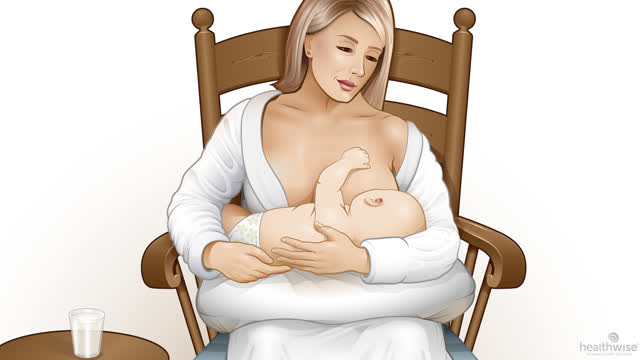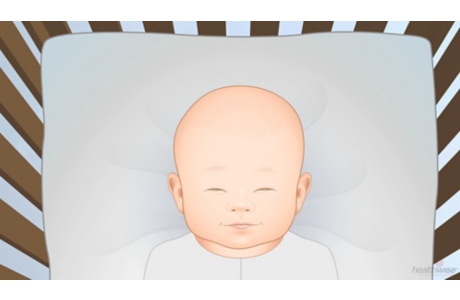Breastfeeding: Sore Nipples
Topic Overview
Pain during breastfeeding is a sign of a problem and should not be ignored. Although sore or tender nipples are common during the first few days of breastfeeding, it should improve. Normal soreness or pain usually occurs for about a minute when the baby first latches on to the breast. Pain that is severe or continuous or that occurs again after it seemed to resolve is a sign of a problem and should be corrected. Other problems may include cracked, bleeding, or bruised nipples.
Sometimes sore nipples develop when the baby begins to suck harder because he or she is not getting milk quickly. This often is caused by:
- Improper positioning.
- Problems with latching on.
- A poor let-down reflex.
- Inverted nipples.
Sore nipples and breasts may also result from:
- The baby sucking for comfort (“hanging out”) without a proper latch after falling asleep at the breast.
- Pulling the baby’s mouth away from the breast without first breaking the suction.
- The baby having a short frenulum (the frenulum connects the tongue to the bottom of the mouth). This is also called “tongue-tie.”
Before and during breastfeeding
- If your doctor says it is okay, take acetaminophen (such as Tylenol) about 30 minutes before breastfeeding.
- Make sure that your baby is latching on correctly. View a slideshow on latching to learn how to get your baby to latch on.
- To minimize discomfort, start breastfeeding on the side that is less sore for the first few minutes, then switch to the other side. The baby’s initial sucking is usually the most vigorous.
- Express a little milk from your breasts right before a feeding. This can help with the let-down reflex and soften nipples so that the baby can easily and gently latch on.
- Change your baby’s position with each feeding. This changes the pressure from the baby’s mouth to a different part of the breast.
General breast care and treatment for sore nipples
- Allow some breast milk to dry on your nipples. Breast milk contains natural skin softeners and antibodies to fight infection, which can help heal nipples and keep them healthy.
- Let your nipples air-dry after each feeding. This prevents clothing from sticking to and irritating the breast. Moistening the nipple helps detach stuck clothing.
- Apply modified lanolin or other specially formulated ointments or creams made with hypoallergenic ingredients (such as Lansinoh or Tender Care).
- To reduce pain, apply cool compresses to your nipples after breastfeeding. Gel pads can also be used on dry nipples.
- If your nipples are very sore, placing breast shields inside your bra to prevent contact between clothes and nipples may help.
- Use proper breast support. Cotton bras with wide, nonelastic straps will help support your breasts without irritating the nipples. Breastfeeding bras open at each cup to allow breastfeeding and to allow nipples to air-dry. If it is more comfortable, wear a bra at night for extra support.
- If your nipples are very sore, ask your doctor or lactation consultant to check your baby’s tongue for a short frenulum. A short frenulum (which connects the tongue to the bottom of the mouth) can limit the baby’s tongue movement and cause pain.
Be sure to contact your doctor or a lactation consultant if you continue to have sore, red nipples after trying home treatment for a day or two.
Avoid:
- Breastfeeding pads that have plastic liners.
- Most general-purpose lotions and creams. These are not recommended because their properties have an unknown effect on both your nipples and your baby.
- Washing your nipples with soap. Soap removes the nipples’ natural lubricants and will dry them out.
Cracked or bleeding nipples
If your nipples are cracked or bleeding, it’s okay to continue breastfeeding your baby. To help relieve your discomfort, use the care tips given above. Call your doctor or a lactation consultant if you find it too painful to breastfeed or if you’ve tried home treatment for 24 hours and it doesn’t help.
Watch for signs of infection, such as a fever, flu-like symptoms, or a painful area on the breast that may be reddened, warm to the touch, or both.
Call your doctor now if you have:
- Increasing pain in one area of the breast.
- Increasing redness in one area of the breast or red streaks extending away from an area of the breast.
- Drainage of pus from the nipple or another area of the breast.
- A hard area in your breast and you are not able to empty your breast.
- A fever of 101°F (38.5°C) or higher.
Call your doctor today if you have:
- Swollen glands (lymph nodes) in the neck or armpit.
- A fever less than 101°F (38.5°C).
References
Other Works Consulted
- American Academy of Pediatrics and American College of Obstetricians and Gynecologists (2012). Care of the newborn. In Guidelines for Perinatal Care, 7th ed. pp. 265–319. Elk Grove, IL: American Academy of Pediatrics.
- Lawrence RM, Lawrence RA (2009). The breast and physiology of lactation. In RK Creasy et al., eds., Creasy and Resnik’s Maternal-Fetal Medicine, 6th ed., pp. 125–142. Philadelphia: Saunders Elsevier.
- Pessel C, Tsai MC (2013). The normal puerperium. In AH DeCherney et al., eds., Current Diagnosis and Treatment Obstetrics and Gynecology, 11th ed., pp. 190–213. New York: McGraw-Hill.
Current as of: May 29, 2019
Author: Healthwise Staff
Medical Review:Sarah Marshall MD – Family Medicine & Kathleen Romito MD – Family Medicine & Adam Husney MD – Family Medicine & Kirtly Jones MD – Obstetrics and Gynecology
This information does not replace the advice of a doctor. Healthwise, Incorporated, disclaims any warranty or liability for your use of this information. Your use of this information means that you agree to the Terms of Use. Learn how we develop our content.







